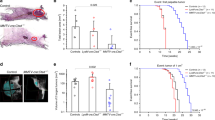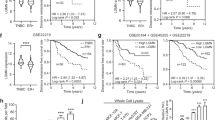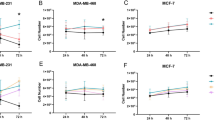Abstract
Cathepsin-D, a lysosomal aspartyl proteinase, is highly secreted by breast cancer cells and its over-expression by transfection stimulates cancer cell proliferation. The mechanism by which this protease affects proliferation remains, however, unknown. In order to determine whether proteolytic activity is necessary, we abolished its enzymatic activity using site-directed mutagenesis followed by stable transfection in 3Y1-Ad12 cancer cells. Substitution of the aspartic acid residue 231 by an asparagine residue in its catalytic site abrogated the cathepsin-D proteolytic activity but did not affect its expression level, processing or secretion. However, like wild-type cathepsin-D, this mutated catalytically-inactive cathepsin-D retained its capacity to stimulate proliferation of cells embedded in Matrigel or collagen I matrices, colony formation in soft agar and tumor growth in athymic nude mice. Addition on the mock-transfected cells, of either conditioned media containing the wild-type or the mutated pro-cathepsin-D, or of the purified mutated pro-cathepsin-D, partially mimicked the mitogenic activity of the transfected cathepsin-D, indicating a role of the secreted pro-enzyme. Moreover, addition of two anti-cathepsin-D antibodies on the cathepsin-D transfected cells inhibited their proliferation, suggesting an action of the secreted pro-cathepsin-D via an autocrine loop. A synthetic peptide containing the 27-44 residue moiety of the cathepsin-D pro-fragment was, however, not mitogenic suggesting that a receptor for the pro-fragment was not involved. Furthermore, the cathepsin-D mitogenicity was not blocked by inhibiting the interaction of pro-cathepsin-D with the mannose-6-phosphate receptors. Our results altogether demonstrate that a mutated cathepsin-D devoid of catalytic activity is still mitogenic and suggest that it is acting extra-cellularly by triggering directly or indirectly a yet unidentified cell surface receptor.
This is a preview of subscription content, access via your institution
Access options
Subscribe to this journal
Receive 50 print issues and online access
$259.00 per year
only $5.18 per issue
Buy this article
- Purchase on Springer Link
- Instant access to full article PDF
Prices may be subject to local taxes which are calculated during checkout









Similar content being viewed by others
References
Bissell MJ, Weaver VM, Lelièvre SA, Wang F, Petersen EW, Schmeichel KL . 1999 Cancer Res. 59: 1757s–1764s
Briozzo P, Badet J, Capony F, Pieri I, Montcourrier P, Barritault D, Rochefort H . 1991 Exp. Cell Res. 194: 252–259
Capony F, Morisset M, Barrett AJ, Capony F, Broquet P, Vignon F, Chambon M, Louisot P, Rochefort H . 1987 J. Cell. Biol. 104: 253–262
Capony F, Rougeot C, Montcourier P, Cavaillès V, Salazar G, Rochefort H . 1989 Cancer Res. 49: 3904–3909
Carney DH, Cunningham DD . 1978 Cell 15: 1341–1349
Chambers AF, Matrisian LM . 1997 J. Natl. Cancer I. 89: 1260–1270
De Clerck YA, Imren S . 1994 Eur. J. Cancer 30A: 2170–2180
De Leon DD, Terry C, Asmerom Y, Nissley P . 1996 Endocrinology 137: 1851–1859
Edwards DR, Murphy G . 1998 Nature 394: 527–528
Emerman JT, Enani J, Pitelka DR, Nandi S . 1977 Proc. Natl. Acad. Sci. USA 74: 4466–4470
Fang W, Hartmann N, Chow D, Riegel AT, Wellstein A . 1992 J. Biol. Chem. 267: 25889–25897
Faust PL, Kornfeld S, Chirgwin JM . 1985 Proc. Natl. Acad. Sci. USA 82: 4910–4914
Ferrandina G, Scambia G, Bardelli F, Panici B, Mancuso S, Messori A . 1997 Br. J. Cancer 76: 661–666
Foekens JA, Look MP, Bolt-de Vries J, Meijer-van Gelder ME, van Putten WLJ, Klijn JGM . 1999 Br. J. Cancer 79: 300–307
Freiss G, Vignon F, Rochefort H . 1988 Cancer Res. 48: 3709–3715
Fusek M, Vetvicka VJ . 1994 Biochem. J. 303: 775–780
Garcia M, Capony F, Derocq D, Simon D, Pau B, Rochefort H . 1985 Cancer Res. 45: 709–716
Garcia M, Derocq D, Pujol P, Rochefort H . 1990 Oncogene 5: 1809–1814
Kane SE, Gottesman MM . 1990 Semin. Cancer Biol. 1: 127–136
Kohl NE, Emini EA, Schleif WA, Davis LJ, Heimbach JC, Dixon RA, Scolnick EM, Sigal IS . 1988 Proc. Natl. Acad. Sci. USA 85: 4686–4690
Laurent-Matha V, Farnoud MR, Lucas A, Rougeot C, Garcia M, Rochefort H . 1998 J. Cell Sci. 111: 2539–2549
Liaudet E, Derocq D, Rochefort H, Garcia M . 1995 Cell Growth Differ. 6: 1045–1052
Lin XL, Wong RN, Tang J . 1989 J. Biol. Chem. 264: 4482–4489
Liotta LA, Rao CN, Wewer UM . 1986 Ann. Rev. Biochem. 55: 1037–1057
Mathieu M, Rochefort H, Barenton B, Prebois C, Vignon F . 1990 Mol. Endocrinol. 4: 1327–1335
Metcalf P, Fusek M . 1993 EMBO J. 12: 1293–1302
Montcourrier P, Mangeat PH, Valembois C, Salazar G, Sahuquet A, Duperray C, Rochefort H . 1994 J. Cell. Sci. 107: 2381–2391
Montcourrier P, Silver IA, Farnoud R, Bird I, Rochefort H . 1997 Clin. Exp. Metast. 15: 382–392
Rifkin DB . 1997 Fibrinol. Proteol. 11: 3–9
Rochefort H, Capony F, Garcia M, Cavaillès V, Freiss G, Chambon M, Morisset M, Vignon F . 1987 J. Cell. Biochem. 35: 17–29
Rochefort H . 1992 Eur. J. Cancer 28A: 1780–1783
Rochefort H, Liaudet-Coopman E . 1999 APMIS 107: 86–95
Seelmeier S, Schmidt H, Turk V, Von Der Helm K . 1988 Proc. Natl. Acad. Sci. USA 85: 6612–6616
Sloane BF, Honn KV . 1984 Cancer Metastasis Rev. 3: 249–263
Thompson EW, Paik S, Brünner N, Sommers CL, Zugmaier G, Clarke R, Shima TB, Torri J, Donahue S, Lippman ME, Martin GR, Dickson RB . 1992 J. Cell. Physiol. 150: 534–544
Veith FO, Capony F, Garcia M, Chantelard J, Pujol H, Veith F, Zajdela A, Rochefort H . 1983 Cancer Res. 43: 1861–1868
Vetvicka V, Vetvickova J, Fusek M . 1999 Breast Cancer Res. Treat. 57: 261–269
Vignon F, Capony F, Chambon M, Freiss G, Garcia M, Rochefort H . 1986 Endocrinology 118: 1537–1545
Vignon F, Rochefort H . 1992 Breast Cancer Res. Treat. 22: 47–57
Wittlin S, Rosel J, Hofmann F, Stover DR . 1999 Eur. J. Biochem. 265: 384–393
Acknowledgements
We thank Dr F Vignon for helpful discussions and suggestions, Dr P Roger for pathology advice, V Gaubiac, M Gleizes and A Lucas for technical assistance, JY Cance for photographs and drawing of figures, and N Kerdjadj and E Moreno for secretarial assistance. This work was supported by the University of Montpellier I, the ‘Institut National de la Santé et de la Recherche Médicale,’ the ‘Association pour la Recherche sur le Cancer,’ the ‘Institut de Recherches Servier’ and the ‘Ligue Nationale contre le Cancer, Comité de l'Hérault’.
Author information
Authors and Affiliations
Corresponding author
Rights and permissions
About this article
Cite this article
Glondu, M., Coopman, P., Laurent-Matha, V. et al. A mutated cathepsin-D devoid of its catalytic activity stimulates the growth of cancer cells. Oncogene 20, 6920–6929 (2001). https://doi.org/10.1038/sj.onc.1204843
Received:
Revised:
Accepted:
Published:
Issue Date:
DOI: https://doi.org/10.1038/sj.onc.1204843
Keywords
This article is cited by
-
The noncanonical role of the protease cathepsin D as a cofilin phosphatase
Cell Research (2021)
-
Inter-organ signalling by HRG-7 promotes systemic haem homeostasis
Nature Cell Biology (2017)
-
Sequence, Structural Analysis and Metrics to Define the Unique Dynamic Features of the Flap Regions Among Aspartic Proteases
The Protein Journal (2017)
-
Extracellular vesicles are transferred from melanocytes to keratinocytes after UVA irradiation
Scientific Reports (2016)
-
Cathepsin D is partly endocytosed by the LRP1 receptor and inhibits LRP1-regulated intramembrane proteolysis
Oncogene (2012)



